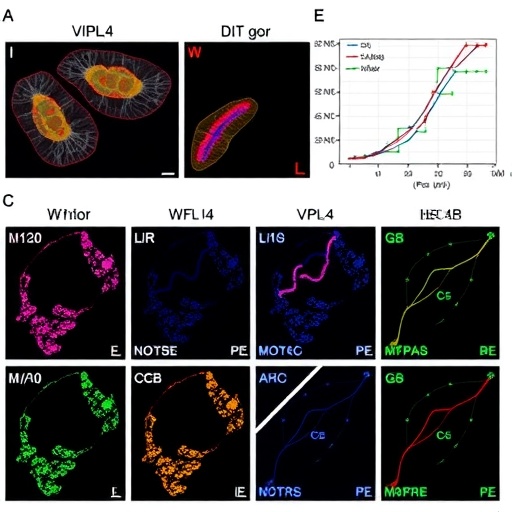In a groundbreaking study published in BMC Genomics, researchers led by Chen et al. have unveiled the intricate dynamics of microRNA expression in the liver of mice subjected to various stages of Echinococcus multilocularis infection. This research holds significant implications for understanding host-parasite interactions, advancing therapeutic strategies, and potentially reshaping our approaches to treating echinococcosis, a debilitating zoonotic disease caused by the parasitic tapeworm Echinococcus multilocularis.
Echinococcus multilocularis is notorious for causing alveolar echinococcosis in humans, which can result in severe liver damage, and in some cases, it is lethal. This complex relationship between the parasite and the host’s immune response underscores the need for detailed molecular studies to elucidate the underlying mechanisms of infection. In their meticulous investigation, the research team embarked on a comprehensive analysis of microRNA profiles in mice at different times following infection with this particular parasite.
MicroRNAs (miRNAs) are small, non-coding RNA molecules that play pivotal roles in the regulation of gene expression. They can modulate various biological processes including cellular differentiation, proliferation, and apoptosis. Understanding how these molecules are expressed during the course of Echinococcus multilocularis infection can provide insights into changes in liver physiology and the host immune response. The research team aimed to clarify these patterns by comparing microRNA levels across distinct phases of the infection.
The study involved a systematic approach whereby liver samples were collected at multiple infection stages. Subsequent RNA extraction and sequencing techniques enabled the researchers to identify and quantify the changes in microRNA expression. Advanced bioinformatics tools were utilized to analyze the data, allowing the team to determine which specific miRNAs were upregulated or downregulated at various time points during the infection. This analytical framework not only highlighted the dynamics but also pointed toward crucial miRNAs that could be targets for future therapeutic interventions.
One of the key findings of the research was the identification of several miRNAs whose expression was markedly altered as the infection progressed. These changes were hypothesized to correlate with host responses aimed at combating the parasitic invasion. Notably, miRNAs involved in immune modulation and inflammation exhibited significant fluctuation during the different stages of infection, suggesting a coordinated host effort to mount an effective immune response.
Another vital aspect of this study was its potential translational implications. By understanding the modulation of microRNA expression in response to Echinococcus multilocularis infection, researchers might be able to identify biomarkers for early diagnosis or prognosis of alveolar echinococcosis. Early detection is crucial as it significantly improves treatment outcomes, and such biomarkers could facilitate more timely therapeutic strategies.
Moreover, the insights gained from this research may assist in developing novel treatment modalities. For instance, if certain miRNAs are found to inhibit the immune response, therapeutic approaches aimed at regulating these miRNAs could bolster the host’s ability to fight off the infection. This could represent a paradigm shift in the management of echinococcosis, expanding the treatment arsenal beyond traditional antiparasitic drugs.
Furthermore, the researchers acknowledged the complexities of host-parasite interactions and how these dynamics can vary significantly between different individuals. By using mouse models, the team aimed to establish foundational knowledge that can be tested and translated into human studies. The implications of this work extend to other parasitic infections as well, providing a framework for understanding microRNA involvement in various infectious diseases.
As the scientific community continues to grapple with emerging infectious diseases, studies like those conducted by Chen et al. are essential. They underscore the link between molecular biology and practical health solutions. The ability to decipher the roles of microRNAs in response to pathogens not only enhances basic scientific knowledge but also paves the way for innovative approaches to disease management.
In closing, this detailed analysis of microRNA expression dynamics during Echinococcus multilocularis infection in mice serves as a compelling illustration of how fundamental research can inform clinical strategies. The careful examination of host immune responses, through the lens of microRNA biology, opens new avenues for enhancing our approach to treating zoonotic diseases and protecting public health on a global scale.
As the fight against parasitic infections continues, the findings of this study hold promise for future research and therapeutic development, highlighting the importance of molecular insights in combating diseases that have significant health implications worldwide. Continued investigation will be essential in order to fully understand the complexities of host-parasite interactions, ultimately contributing to enhanced treatment strategies and improved patient outcomes.
Subject of Research: Dynamics of microRNA expression in mouse liver during Echinococcus multilocularis infection.
Article Title: MicroRNA expression dynamics in mouse liver at different stages of Echinococcus multilocularis infection.
Article References: Chen, Y., Gao, HJ., Li, C. et al. MicroRNA expression dynamics in mouse liver at different stages of Echinococcus multilocularis infection. BMC Genomics 26, 941 (2025). https://doi.org/10.1186/s12864-025-12049-z
Image Credits: AI Generated
DOI:
Keywords: MicroRNA, Echinococcus multilocularis, liver infection, host-parasite interactions, therapeutic strategies.
Tags: alveolar echinococcosis and liver damageBMC Genomics research on microEchinococcus multilocularis infection dynamicsgene expression regulation by microRNAshost-parasite interactions in echinococcosisimmune response to parasitic infectionsimplications for treating echinococcosisliver physiology and microRNA dynamicsmicroRNA expression in mouse livermicroRNA profiles during infectionmolecular studies of Echinococcus infectiontherapeutic strategies for zoonotic diseases





